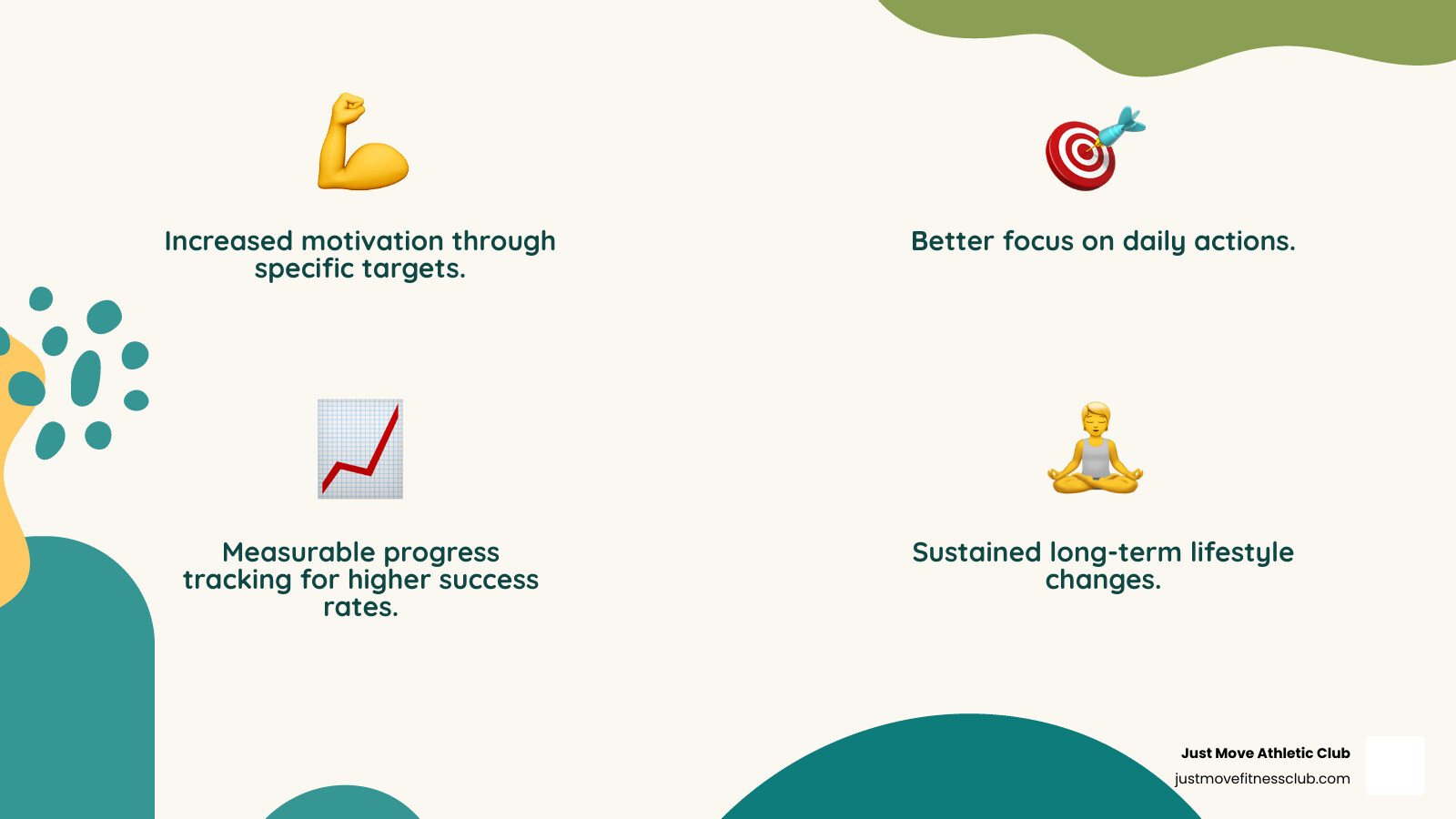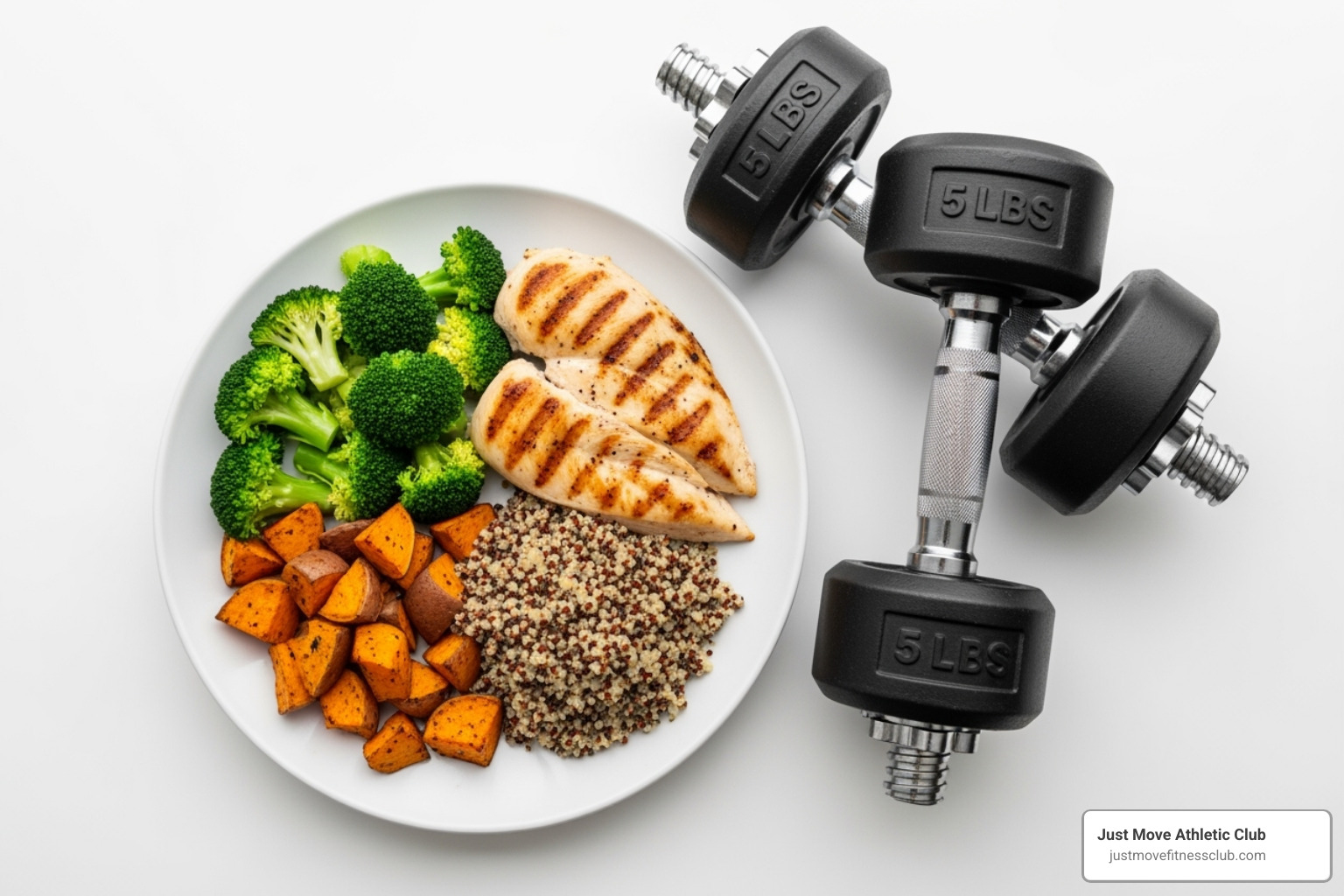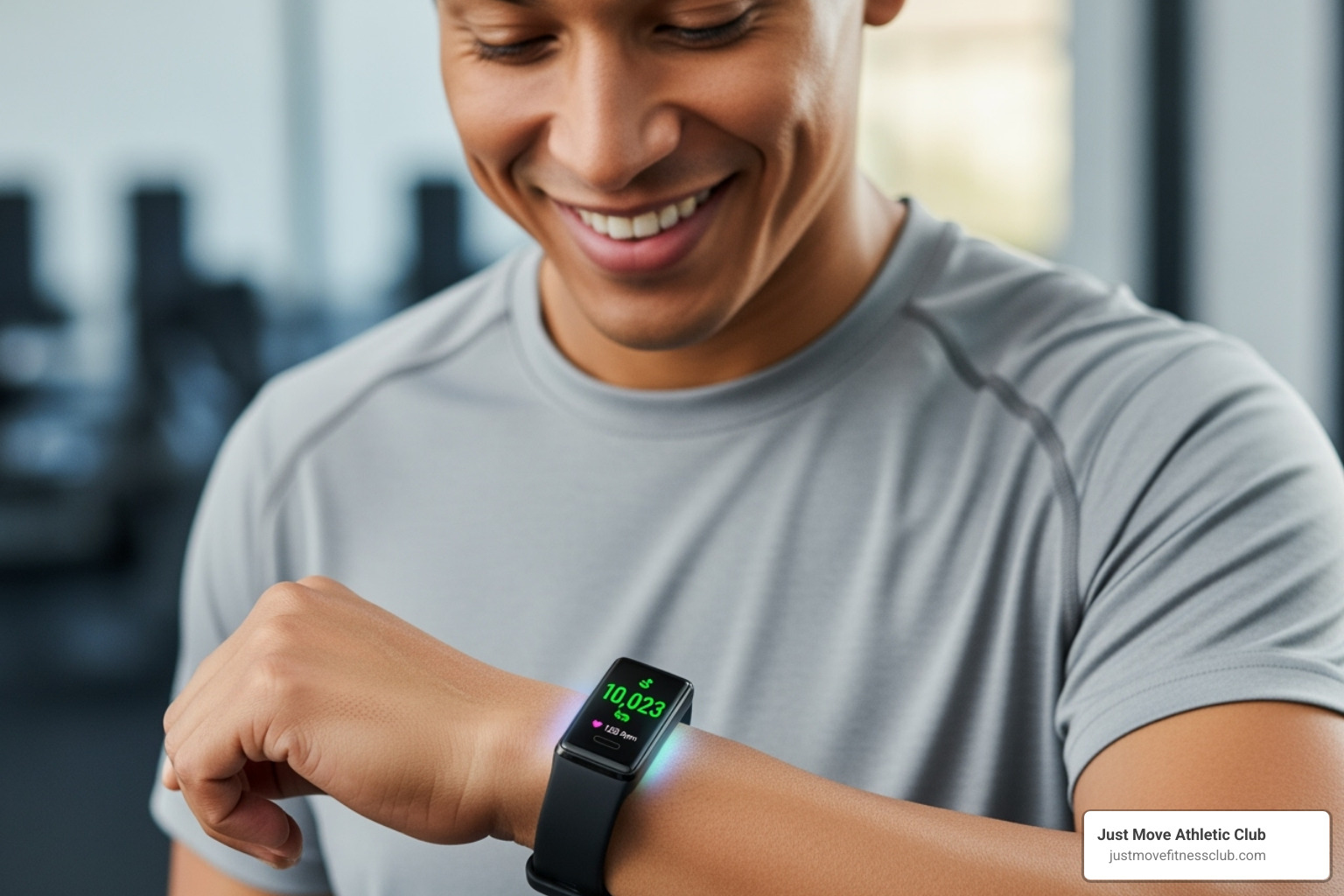Why Setting Clear Fitness Goals Transforms Your Health Journey
To achieve fitness goals consistently, you need proven strategies that turn aspirations into measurable results. Research shows that people who set specific goals exercise more and stick with their routines longer than those who simply hope to “get in shape.”
Quick Answer: How to Achieve Fitness Goals
- Set SMART goals – Specific, Measurable, Attainable, Relevant, Time-bound
- Create a balanced plan – Combine cardio, strength training, and proper nutrition
- Track your progress – Use apps, journals, or measurements to monitor results
- Stay accountable – Find workout partners or join fitness communities
- Adapt when needed – Adjust your plan for setbacks or changing circumstances
While making any lifestyle change can be challenging, having a clear goal provides motivation and a way to measure success. Shifting from a vague wish like “I want to get fit” to a specific target like “I will run a 5K in under 30 minutes within three months” sets you up for success.
The difference between success and failure often comes down to a structured approach. Writing down goals, tracking progress, and celebrating small wins leads to lasting results. It’s not about perfection, but consistency and a clear roadmap.
I’m Pleasant Lewis JMAC, and with over 40 years in fitness, I’ve helped thousands achieve fitness goals through proven strategies. At Just Move Athletic Clubs, we’ve seen how the right approach transforms not just bodies, but entire lifestyles.

The Foundation: Setting SMART Goals for Success
To achieve fitness goals, you must trade vague wishes like “get in shape” for crystal-clear targets. This is where the SMART goal framework provides a roadmap you can actually follow.
SMART stands for Specific, Measurable, Attainable, Relevant, and Time-bound. Rooted in behavioral psychology, this method helps build self-efficacy—your confidence that you can succeed. Research on goal setting and action planning confirms that SMART goals help “focus desires and intentions and create a standard by which success can be measured.” They give your brain a concrete path to follow, with measurable milestones along the way.
Setting realistic expectations is crucial. A good goal is challenging enough to be exciting but attainable enough to prevent burnout.
How to Set Specific, Measurable, Attainable, Relevant, and Time-Bound Goals
Let’s break down the SMART framework to build goals that stick.
- Specific: Eliminate guesswork. Instead of “exercise more,” a specific goal is “I will do strength training three times per week.”
- Measurable: Track your progress with numbers. “Lose 10 pounds in 12 weeks” provides a clear benchmark.
- Attainable: Your goal should push you without setting you up for failure. If you’re new to running, aim to “complete a 5K in three months,” not a marathon next month.
- Relevant: Your goals must matter to you. If you hate running, don’t make it your goal. Align your fitness journey with your personal values and lifestyle.
- Time-bound: Deadlines create urgency and focus. A 1-3 month timeframe is often effective, allowing for real progress while maintaining momentum.
Combining these elements transforms wishful thinking into an actionable plan.
Examples of Short-Term and Long-Term Fitness Goals
A successful fitness journey balances quick wins with bigger dreams. Short-term goals (1-3 months) build momentum, while long-term goals (6-12 months) provide a larger vision.
- Building Consistent Habits: “Work out three times per week for one month” or “drink eight glasses of water daily for six weeks.”
- Cardiovascular Improvements: “Run one mile without stopping in eight weeks” or “complete 30 minutes of cardio three times weekly.”
- Strength Training: “Complete 10 proper push-ups in six weeks” or “increase my bench press by 20 pounds in three months.”
- Flexibility and Mobility: “Hold a plank for 60 seconds” or “touch my toes without bending my knees in four weeks.”
Long-term goals could include completing an obstacle course race, significantly improving flexibility, or hitting a major lift weight milestone. Start with shorter goals to build the habits and confidence needed for these larger achievements.
How to Achieve Fitness Goals with a Sustainable Plan

SMART goals are your map, but a sustainable plan is how you follow it. To achieve fitness goals, you need a consistent approach that combines smart workout planning, proper nutrition, and strategic recovery. This isn’t about a quick fix; it’s about building healthy habits for life.
Designing a Workout Plan to Achieve Fitness Goals
An effective workout plan fits your life, matches your fitness level, and progressively challenges you. The Centers for Disease Control and Prevention’s physical activity guidelines for adults are a great starting point: aim for at least 150 minutes of moderate-intensity aerobic activity or 75 minutes of vigorous-intensity aerobic activity weekly, plus strength training for all major muscle groups at least twice a week.
- Build a Balanced Routine: Combine aerobic exercise (walking, cycling) for endurance with strength training (weights, bodyweight) to build muscle and boost metabolism.
- Use Progressive Overload: Start where you are and gradually increase intensity, duration, or weight by about 10% each week. This allows your body to adapt and grow stronger without injury.
- Incorporate Cross-Training: Keep workouts interesting by mixing activities. Try strength training, brisk walking, a fitness class, and High-Intensity Interval Training (HIIT) on different days. HIIT is a time-efficient option for busy schedules.
- Prioritize Rest Days: Muscles grow during recovery, not during the workout. As personal trainer Chris Musser notes, “When you’re feeling really exhausted or sore after a workout, then plan an extra rest day.” Most people need at least two rest days per week.
The Critical Role of Nutrition and Hydration
Proper fuel is non-negotiable for performance and recovery. Nutrition is the foundation that supports all your fitness efforts.
- Macronutrients: Focus on a balance of all three. Carbohydrates (whole grains, fruits) provide sustained energy. Protein (lean meats, beans) is vital for muscle repair and growth, especially when consumed within 45 minutes post-workout. Healthy fats (avocados, nuts) are essential for hormone production.
- Caloric Intake: Your intake depends on your goal. Weight loss requires a slight caloric deficit, while building muscle needs a modest surplus of quality, nutrient-dense calories.
- Hydration: Dehydration hurts performance and recovery. A good guideline is to drink half your body weight in ounces of water daily. Sometimes thirst is mistaken for hunger, so try drinking water first when you feel like snacking.
A combination of smart workouts, proper nutrition, and hydration creates a lifestyle that helps you achieve fitness goals that last.
Staying the Course: Tracking, Accountability, and Adaptation

Initial motivation fades, but systems for consistency are what help you achieve fitness goals long-term. When life gets complicated, tracking, accountability, and adaptation are the keys to staying on course.
Practical Strategies for Tracking Your Progress
Tracking progress allows you to celebrate victories and see what’s working. Without it, you’re flying blind.
- Use a Training Diary or Fitness App: Log your workouts, sets, reps, and how you felt. Digital tools can also track heart rate, sleep, and daily activity, providing valuable feedback.
- Take Progress Photos and Measurements: The scale doesn’t tell the whole story, as muscle weighs more than fat. Photos and a tape measure can reveal changes in body composition that the scale misses.
- Use Advanced Analysis: For the most detailed picture, tools like our Fit3D Pro Body Scanner provide precise measurements of body fat, lean mass, and posture, offering a comprehensive view of your progress.
- Celebrate Milestones: Acknowledge every small win, whether it’s running an extra block or mastering a new exercise. This recognition fuels your motivation.
How to Stay Accountable to Achieve Fitness Goals
Accountability creates a support system that makes showing up easier.
- Find a Workout Buddy: It’s harder to skip a session when someone is counting on you. A friend can also make workouts more fun and motivating.
- Share Your Goals: Tell family and friends what you’re working toward. They can become your biggest cheerleaders.
- Schedule Your Workouts: Treat exercise like a non-negotiable appointment in your calendar to build consistency.
- Join a Fitness Community: Group fitness classes provide built-in motivation, expert guidance, and a supportive social environment.
- Pre-pay for Services: Investing money upfront in classes or a membership creates a powerful psychological commitment to show up.
Adapting Your Plan for Setbacks and Changing Circumstances
Long-term success depends on how you adapt to challenges.
- Handle Illness or Injury: Listen to your body and rest. Adjust your timeline and focus on micro-goals like nutrition or gentle stretching. Return to exercise gradually.
- Stay Active During Travel: Vacations don’t have to derail your progress. Use hotel gyms, go for walks, or do bodyweight exercises to maintain the habit of being active.
- Overcome Plateaus: If progress stalls, your body has adapted—a sign you’ve gotten stronger. Mix up your routine, try new exercises, or increase the intensity to restart progress.
- Practice Self-Compassion: Bad days and missed workouts are part of being human. Don’t beat yourself up. Acknowledge it, learn from it, and get back on track.
Amplifying Your Efforts: Tools and Professional Support

While smart planning is key, the right tools and professional support can significantly boost your efforts to achieve fitness goals. You don’t have to go it alone; high-quality equipment, expert guidance, and group classes can lead to faster, more sustainable results.
The Advantage of High-Quality Gym Equipment
A well-equipped gym provides a safe and efficient environment for success. Quality equipment offers several benefits:
- Safety and Injury Prevention: Ergonomically designed machines guide your movements, reducing injury risk and minimizing strain on joints.
- Effective Muscle Targeting: Precision-engineered machines isolate specific muscle groups for balanced, efficient development.
- Comfort and Variety: Comfortable, smooth-operating equipment makes workouts more enjoyable. A wide variety of machines and tools prevents boredom and keeps your body challenged.
How Personal Trainers and Group Classes Accelerate Results
The human element is invaluable for navigating your fitness journey.
A certified personal trainer provides expert guidance custom to you. They observe your form, design a plan for your specific goals, and offer personalized feedback that no app can replicate. This customized approach makes your workouts more efficient, provides a motivation boost, and creates accountability.
Group classes offer a structured, instructor-led format that removes guesswork. The contagious energy and social interaction transform exercise from a solitary chore into a fun community experience.
At Just Move Athletic Club, our approach is built on these principles. We offer state-of-the-art equipment selected for safety and effectiveness, certified personal trainers who create custom fitness experiences, and diverse group classes for all levels. Combining the right tools with expert guidance and community support makes achieving fitness goals not just possible, but enjoyable.
Frequently Asked Questions about Achieving Fitness Goals
As you work to achieve fitness goals, questions are bound to arise. Here are answers to some of the most common challenges we see at Just Move Athletic Club.
How do I stay motivated when I’m not seeing progress?
Plateaus are a normal part of any fitness journey. When you feel stuck, try these strategies:
- Reassess Your Goals: Your expectations might be too aggressive. Adjust your timeline if needed—consistent progress is still progress.
- Focus on Non-Scale Victories: Are you sleeping better or have more energy? These daily life improvements are significant wins.
- Try New Activities: Combat boredom by swapping your usual routine for a dance class or kettlebell training. Finding activities you enjoy is key to consistency.
- Remember Your “Why”: Reconnect with the deeper reason you started. This intrinsic motivation can carry you through tough patches.
- Rely on Discipline: Motivation ebbs and flows. Discipline is what builds the habit and keeps you going even when you don’t feel like it.
What’s more important for achieving fitness goals: diet or exercise?
Both are crucial and work together synergistically. You can’t have one without the other for lasting results.
- Nutrition often leads for weight management. You can’t out-exercise a poor diet. For weight loss, focus on whole foods, portion control, and balanced macronutrients.
- Exercise is key for body composition and overall health. It shapes your body, builds metabolically active muscle, strengthens your heart, and boosts your mood.
Think of it as an 80/20 split: diet may be 80% of weight loss, but exercise is essential for how you look and feel.
How many rest days should I take per week?
Recovery needs are highly individual and depend on your fitness level, workout intensity, sleep, and stress.
- Listen to your body. Persistent fatigue or soreness are clear signals that you need more rest.
- Aim for 1-3 rest days per week. Rest doesn’t have to be sedentary. Active recovery like gentle walking or stretching can promote blood flow and speed up recovery.
- Muscles grow during rest. The muscle-building process happens when you’re recovering, so skimping on rest works against your progress. Be flexible and take a rest day when your body tells you to.
Start Your Journey to a Healthier You
Your path to achieve fitness goals doesn’t have to be a solo journey. We’ve covered the essentials: setting SMART goals, creating a sustainable plan, tracking progress, and staying accountable. Every action you take builds momentum for tomorrow.
The difference between success and giving up is often having the right support system, tools, and expert guidance. That’s where we come in.
At Just Move Athletic Club, we are dedicated to your success. Our custom fitness experiences provide plans that fit your life and goals, whether through high-energy group classes or focused personal training.
Our state-of-the-art equipment creates a safe, confident environment to push your limits. With our Fit3D Pro Body Scanner, you can track detailed changes in body composition that the scale can’t show you. Our community is a vital part of the experience. When you walk through our doors in Lakeland or Winter Haven, you join a supportive family that celebrates your victories.
Are you ready to turn your fitness dreams into reality? We’re here to help you bridge the gap between where you are and where you want to be.
Join our community today and open up your full potential.

